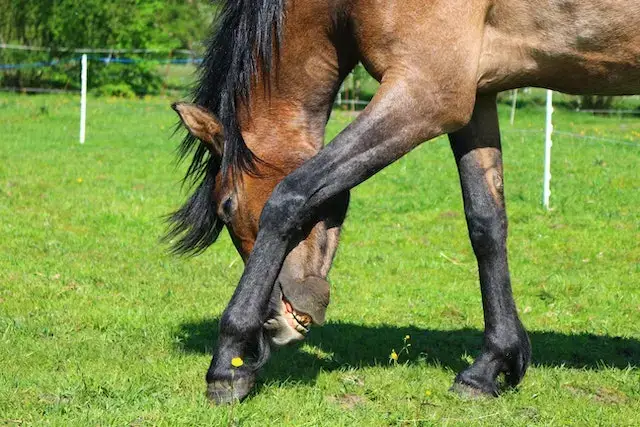
No horse lover wants to see his horse in pain. We all want our horses fit and ready for an adventurous ride. But can you ride a horse with dropped fetlocks?
To begin with, a horse is an animal that needs to be handled carefully. If you have come to this page, you probably just learned about dropped fetlocks. Or you discovered one in your horse.
If that is the case, don’t worry. The fact that you want your horse to be healthy still makes you a good horse owner. So, here is an article to tell you all about your horse and his fetlocks.
Can You Ride a Horse With Dropped Fetlocks?
Yes, it is possible to ride a horse with dropped fetlocks, but make sure to consult with a veterinarian before doing so.
Some sources suggest that it is safe to ride a horse with dropped fetlocks as long as the fetlock is not hitting the ground during a stride, but others caution against it due to the potential discomfort the horse may experience.
Dropped fetlocks can be a sign of degenerative suspensory ligament desmitis (DSLD), a progressive disease that affects the suspensory ligaments in horses.
If a horse has dropped fetlocks, it is recommended to have a veterinarian evaluate the horse to determine the underlying cause and to provide guidance on whether or not it is safe to ride the horse.
Are Dropped Fetlocks Painful?

Yes, a dropped fetlock can indeed be very painful, in turn causing a horse a lot of distress, sometimes more than he can take.
This, if left unattended, can only worsen in time, leading to lameness and, with that, more pain.
If still unattended, it could reach a point where the fetlocks drop to the ground. Physically, this could resemble a bunch of sweet potatoes falling to the ground.
And, of course, one doesn’t need to be told here that this can be very painful to the horse. In time, this can only lead to further complications, laminitis, arthritis, and poor alignment of the joints, which will only add to the pain in the horse.
In severe cases, it can even affect the flow of blood to the foot, which can be fatal. So, take the problem seriously if you want your horse.
As an owner, it is important to perform timely stress tests to keep a check on your horse’s ligaments.
Must Read: What Age Do Horses Hocks Fuse?
What to Look for When Riding – Warning Sign!
Fetlock drop is indeed a serious condition, and an owner needs to be ever-vigilant about the warning signs. Here are three signs to watch out for.
#1. The Joints
You will know it when you see a visible enlargement in your horse’s joint. When this happens, make sure that you rush your horse to the vet.
A lot of times, the disease only progresses, giving the horse excessive pain because an owner never recognized the signs.
Watch out for any kind of abnormal sagging, as this could be one of the first signs of a fetlock drop.
#2. The Walk
As an owner, you must always keep an eye out for signs of discomfort in your horse.
Your horse could also be experiencing fetlock drop if he tends to trip and stumble a lot. His steps are going to be short and choppy as a result of a lot of pressure from bending his joints as he walks.
This is known as gait instability and can even lead to neurological dysfunction in your horse. This may not be visible in an X-ray at first.
As a result, the horse can keep switching his stance as he moves, and this could, over time, lead to a kind of soreness in his back, another warning sign for you.
#3. The Habits
The severe pain that your horse feels will make him want to stop and rest more often. So, if your active horse has begun to spend a lot of time sitting on fences, buckets, and other such objects, then he is perhaps suffering from a dropped fetlock, and you need to take him to the vet.
In time, he is even going to do things like digging holes in the ground to rest his feet in. You may even find him sitting like a dog. All these are some sorry signs that a dropped fetlock has reduced your horse.
So, now that you know how severe the situation can get and what the signs are, you will be watchful and won’t let it reach here, will you?
What Causes Dropped Fetlocks in Horses?

Dropped fetlocks mainly happen as a result of suspensory desmopathy. A horse’s ligament can get weak with a lot of riding. This is especially true with horses that are often made to gallop at high speeds.
This can lead to a lot of stretching. Over time, the leg and the joint go through a lot of trauma. This is technically known as osteochondrosis, which is a kind of fracture in the joints.
This can, in turn, lead his fetlock to drop or sink. This is more so when the horse is made to support a lot of weight.
While this may not happen to some horses, some others are weaker and more susceptible to injuries like a fetlock drop.
Do not take your horse through a lot of deep and uneven ground. Finally, remember that the wrong shoes can also be the culprit in dropping the fetlocks of a horse.
How Do You Treat a Dropped Fetlock Horse?
Remember that you are not the doctor here. So, the first thing to do when you detect a dropped fetlock is to take your horse to the vet, who will conduct a physical examination and arrive at a diagnosis.
The treatment that he provides may depend on the diagnosis. This is why one of the first things that a vet will do is to perform an X-ray to know where the pain is.
That said, there are two ways to treat your injured horse. Read on.
1. Surgery
Surgery is one way to go about it, where the vet gets rid of the fracture through a process called an endoscope. They then repair the fracture with a couple of bone marrow screws.
However, the vet must make sure that he removes small fragments of this, bit by bit. If done right, the process can successfully help the bones grow together solely till the horse is once again strong and back on his feet.
A lot of horse owners split the injured part by surgically removing the lateral plantar nerve. However, many others do not resort to this for the fact that it could cause lameness.
2. Other Traditional Methods
Some traditional options like bandages and anti-inflammatory medication can also be very helpful in helping your horse to heal. Some owners choose to place cold packs on the inflamed area to provide some amount of relief to the horse.
You can wrap your horse’s leg in a plaster or a fiberglass cast and leave this on for 12 weeks.
Some owners even prefer to administer anti-inflammatory drugs to help the horses get over the pain. This can either be injected or fed through the horse’s mouth.
Remember that too much pressure can add to your horse’s pain and slow down the healing process. Training or racing a horse at a time like this has often led to the destruction of a horse’s limbs in many cases.
Support Boots for Dropped Fetlocks
As you saw, fetlock drops are a sign of tension on the flexor tendon of the horse. This makes the right support boots a good solution to spare your horse from unwanted injury.
Make sure that your horse is getting the right heel support at all times, which means you need to keep the shoeing intervals short.
What you need to know is that a horse often has delicate tendons that can wear with all the rides he gives his owner.
These tendons run the entire length of the horse’s cannon bone, so any injury can affect the whole leg.
Recommended Reading: Do Horses Have Nerves In Their Hooves?
Wrapping Up
Injuries are common with a horse, but the least we can do is keep it to a bare minimum. Owning a horse is fun but also comes with a lot of care and protection, and this doesn’t stop at food and water to drink.
Make sure that your horse is always equipped with the right gear and that you have the time to frequently check on him.
What’s more, all this will only make your horse feel loved as he sees the amount of concern you show to him.
And can you ride a horse with dropped fetlocks? The answer is no, you cannot.
Frequently Asked Questions
Q1. What does it mean when a horse has a dropped fetlock?
Ans: This is a condition that most often affects the hind limbs but can also occur in the rear limbs of the horse. In the case of the latter, know that the horse is going to take a little more time to heal, so don’t rush to send him racing.
Q2. What causes dropped pasterns in horses?
Ans: Too much weight is the main cause of dropped fetlocks in a horse. Horses love carrying their masters, but they can only take so much weight. More than that, it can damage the supporting structures of the leg. And this will, in turn, lead to a fetlock drop.
Q3. Can you ride a horse with DSLD?
Ans: No. To do so would not only be dangerous but mean, too, now that you know that a horse in this condition is going through too much pain to entertain you. You can take a horse to the vet if he has DSLD, but no, you cannot ride him, even if he says he is willing.



